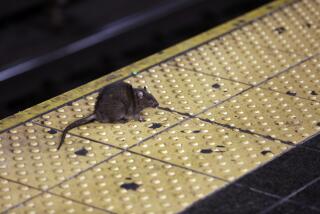Hunters Try to Save Desert Rat : Conservation: Among 260 Roo Rat Society members are students, doctors, professors and college presidents. Their greeting: ‘A-roo,’ says one. ‘A-rat,’ is the response.
- Share via
WALLA WALLA, Wash. — Duncan Cox’s moonlight ride into the southeastern Washington desert must have seemed like a snipe hunt.
The car’s headlights illuminated the dirt road and the dry, brushy landscape of Wallula Gap, but there wasn’t a roo in sight.
“Pickings were scarce that night,” Cox said, recalling his initiation into the Roo Rat Society. “It was starting to look like no rats would deign to honor us with a catch.”
The object of his initiation was a kangaroo rat, a hopping, long-tailed creature that lives in arid settings from Canada to Mexico.
The point of this 29-year-old society is to foster conservation ideals among members, some of whom are greatly affected by an encounter with the little wild animal, said retired Whitman College chemistry professor Jim Todd, a founder of the group.
“It’s hoped that the ideas of the society turn a person on to the conservationist movement,” Todd said.
It’s not uncommon for potential members to initially suspect the desert foray is a snipe hunt, a search for something that can’t be found, Todd said.
But few forget what it’s like to catch and hold the “neatest animal in fur,” he said.
The nighttime hunt must be led by a member. There are a number of rules to ensure the sincerity of inductees and the safety of the roos.
“Catching the roo rat by the tail is prohibited because it’s a painful thing,” Todd said.
As the slow-moving car creeps along a dusty road, all eyes scan for the unpredictable kangaroo rat. The record number spotted in an hour: 55.
A cry of “a roo to the right!” brings the car to a halt and the initiate scrambles out. Cox believes nabbing a rat is easier for the coordinated and dexterous. He says he is neither.
“My catch was not so glorious,” Cox recalled. But once in hand, the furry brown roo rat seemed to acquiesce.
“It’s just the coolest, most sedate creature you can imagine,” Cox said. “He just sort of sat there in my hands, he walked up my arm, sat on my shoulder, and I put him back in the grass.”
The card-carrying brothers and sisters in the Roo Rat Society now number 260. The ranks of roo ratters include students, doctors, professors and college presidents.
They know each other by this greeting: “A-roo,” says one. “A-rat,” is the response.
Todd and four students started the society on May 18, 1963, on a trip to the Malheur National Wildlife Refuge in southeastern Oregon. They were collecting biological specimens to study the skins.
The society has grown kinder and gentler over the years with care taken to protect the roo and its 4-inch tail. The creature must be freed quickly after catching.
Most of the hunts occur at Wallula Gap near the Columbia River, 30 miles west of Walla Walla.
“It really should be more of an encounter than a hunt,” Todd said.
Whitman College President David Maxwell was initiated last year in a snowstorm.
“It certainly is fun, certainly an adventure, but it’s meant to be a symbolic adventure,” he said. “I think there is a higher purpose.”
“There were a lot of roo rats out there. They’re also a lot faster and a lot more clever than I was led to believe.”
Clever and adorable by all accounts, roo rats resemble gerbils, but Todd says a roo is infinitely cuter.
Todd recalled only one person being bitten, someone who caught the roo with one hand and accidentally squeezed it.
Initiates are advised to wear gloves. Something called a two-handed muffle catch--a tender, openhanded catch--or variations are recommended for cornering the quarry.
The speediest catch was made in 10 minutes by a woman initiate. “She saw, she ran, she conquered,” Todd said. “We turned around, went back to Walla Walla and had a pizza.”
More to Read
Sign up for Essential California
The most important California stories and recommendations in your inbox every morning.
You may occasionally receive promotional content from the Los Angeles Times.













